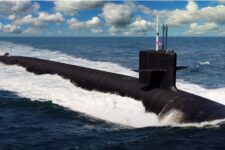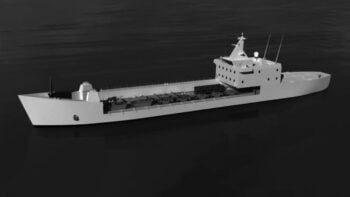
WASHINGTON: The V-22 Osprey that crashed during a military exercise in southern Morocco, killing two Marine crew chiefs, had just dropped troops off in a landing zone on a clear day and was flying away when the accident occurred, military sources tell Breaking Defense.
Those circumstances might seem to suggest that the tiltrotor troop transport malfunctioned, the sources said, but they added that neither the Marines nor the Air Force suspended flights by the rest of their V-22 fleets in the wake of the accident – a strong sign no mechanical failure is suspected.
“The fact that the Marine Corps and Air Force have not grounded the V-22 strongly suggests that something other than an aircraft malfunction was at fault here,” a military officer who has participated in accident investigations said.
The investigation into the Morocco accident has just begun, however, and the aircraft’s Crash Survivable Memory Unit, the “black box” that records key flight data, could prove otherwise. Investigators also may be aided in finding the cause of the crash by the fact that the two pilots survived.
The North Carolina-based 2nd Marine Air Wing announced Friday that Cpl. Robby A. Reyes of Los Angeles and Cpl. Derek A. Kerns of Fort Dix, N.J., of Marine Medium Tiltrotor Squadron 261, based at New River, N.C., were killed in the Wednesday accident. Their ages weren’t listed, but the news release said Reyes joined the Marine Corps in 2007 and Kerns in 2008. The names of the two pilots, who were evacuated from Morocco with serious injuries, were being withheld “for their privacy and the privacy of their families,” the news release said.
Whatever caused the loss of their Osprey, the odds are strongly against the mishap affecting the future of the tiltrotor troop transport program in Washington. The V-22 program is in better shape politically than ever before.
The Osprey, which tilts two large wingtip rotors up to fly like a helicopter and swivels them forward to fly with the speed and range of a fixed-wing turboprop, cost the Marines 25 years, $22 billion and 30 deaths in three crashes during its development. Since they put the Osprey into service in Iraq in 2007, though, the V-22 has been one of the safest aircraft the Marines fly, and both they and the Air Force, which flies the CV-22 on special operations, have found the tiltrotor’s speed, range and survivability compared to helicopters a huge advantage.
In 13 deployments to Iraq, Afghanistan and with seaborne Marine Expeditionary Units, Marine Corps Ospreys have delivered supplies to outlying bases, troops to firefights and casualties to medical care in far less time than helicopters would have required. They’ve also done those things at less risk of being hit by enemy fire, for the Osprey usually cruises at about 8,000 feet, far above the small arms and rocket-propelled grenades that pose a threat to low-flying helicopters.
The Marines used Ospreys to pick up a downed U.S. pilot in Libya before he could be captured by hostile forces. The Marines have also found that using Ospreys to move parts and personnel back and forth allows three-ship Amphibious Ready Groups to operate at far greater distances from one another and the shore – 300 miles compared to 75 using CH-46E helicopters.
Critics in Congress and elsewhere want to cancel the Osprey program because of its cost — a Marine Corps MV-22 costs about $67 million and an Air Force CV-22 about $78 million — or because they distrust the Osprey’s tiltrotor technology. Some may use the crash in Morocco as an occasion to claim the Osprey is “accident-prone.” The Marines and Air Force, however, have lost only two Ospreys to fatal accidents in the past 12 years at a cost of six lives. During roughly the same period, the U.S. armed services combined have lost 411 conventional helicopters at a cost of nearly 600 American lives.
Based on “Class A” mishaps per 100,000 flight hours, meaning accidents involving fatalities or permanent disability or more than $2 million in damage to property or aircraft, the V-22 no longer ranks as the safest Marine Corps combat rotorcraft flying after the Morocco crash. Marine Corps spokesman Capt. Brian Block said the AH-1Z Viper attack helicopter, a remanufactured version of the AH-1W SuperCobra, now ranks as the safest Marine Corps rotorcraft with no accidents, followed by the CH-46E Sea Knight. The AH-1Z, though, is on its very first deployment with the 11th Marine Expeditionary Unit and has far fewer than 100,000 flight hours. CH-46Es, meanwhile, have flown more than 700,000 hours since 2001, compared to about 115,000 hours for Marine Corps and 15,000 hours for Air Force Ospreys.
The F-35B Joint Strike Fighter has replaced the Osprey as the Marines’s top aviation priority, but the Corps’ leaders still love the V-22. If a serious attempt to cancel it were to arise, they would surely fight even harder to keep it now than their predecessors did from 1989-92, when a powerful defense secretary, Dick Cheney, did his best to scrap the V-22 but was defeated by the Marines, their friends in Congress and Osprey-makers Bell Helicopter Textron Inc. and Boeing. And that was when the V-22 had barely flown.
The current defense secretary, Leon Panetta, seems to love flying on the Osprey himself, as do other civilian Pentagon leaders who’ve ridden in it. The fact that senior leaders like Panetta fly in the Osprey is an important symbolic expression of their confidence in its safety record.
For budget reasons, the Pentagon is buying fewer than the 122 V-22s that had been planned over the next five fiscal years, but the Department of Defense recently reported to Congress that it plans to buy 91 more MV-22s and seven CV-22s under a new fixed-price contract with Bell and Boeing that will run from fiscal 2013-2017. In his letter to the Hill, Undersecretary of Defense Frank Kendall said the contract, to be signed by the end of this year, will save the government $852 million compared to what it would cost to buy the same number of Ospreys on annual contracts. The Marines also still plan to buy 24 more MV-22s after 2017.
At the Navy’s invitation, meanwhile, the Marines have started qualifying the Osprey to land on big-deck aircraft carriers. The Navy is considering the V-22 as a possible replacement for its C-2A Greyhound carrier on-board delivery aircraft, which bring cargo and passengers to carriers. The V-22 program manager at the Naval Air Systems Command, Col. Greg Masiello, says he’s also very confident one or more foreign nations will soon decide to buy V-22s.
Add it all up, and it’s pretty clear the Osprey is here to stay.
‘Mind-boggling’: Israel, Ukraine are mere previews of a much larger Pacific missile war, officials warn
MDA Chief Lt. Gen. Heath Collins said more maneuverable missiles and drones have changed the missile defense game: Instead of just preparing to hit “fastballs,” he said, “now we’re hitting sliders and curveballs.”



























